What is better for the washing machine: gel or powder?
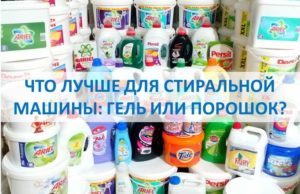 Manufacturers now offer for sale a huge variety of products used to clean clothes. Along with the familiar washing powder, special gels appear, produced either in the form of capsules or in bottles with a cap. Is it really better to buy a liquid product, or is this all nothing more than good advertising and fashion of the 21st century? What to choose, time-tested washing powder or washing gel? We'll figure out.
Manufacturers now offer for sale a huge variety of products used to clean clothes. Along with the familiar washing powder, special gels appear, produced either in the form of capsules or in bottles with a cap. Is it really better to buy a liquid product, or is this all nothing more than good advertising and fashion of the 21st century? What to choose, time-tested washing powder or washing gel? We'll figure out.
Why do housewives choose gel?
The gel is a special solution containing surfactant particles. The main difference between gel and powder can be considered the most delicate effect on the fabric of the former, due to which the substance can be used for daily cleansing of things.
According to the instructions for use of the detergent, it can be used in water heated to 30 - 40 degrees. Most washing modes in automatic machines have exactly this temperature setting, so the gel is perfect for cleaning synthetics, woolen items, delicate fabrics, and outerwear. Powders are used in an extended range - up to 90°C; they are perfect for washing linen and cotton fabrics.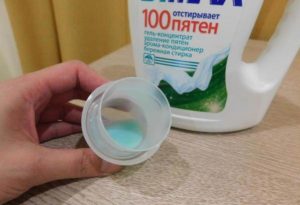
The next difference is the presence in the gel composition of a smaller percentage of anionic surfactants and a larger number of surfactants belonging to the group of cations and nonionics. The liquid form is recommended to freshen clothes that are worn very often; it has a delicate effect on things.
However, when the housewife has to deal with stubborn, difficult-to-remove stains, it is better to buy powder and set up a high-temperature wash. To enhance the effect of the gel on fabrics, special capsules have been invented that are placed directly into the cavity of the machine drum on a pile of laundry and prevent the gel-like product from being washed out of the washing machine dispenser. The gel loaded into the machine in this way combines with the liquid faster and acts immediately.
As for hand washing with gel pouring, it will not be as effective as the machine process. During rotation of the drum, mechanical activation is observed, providing a sufficient cleaning effect. When cleaning things with your hands, this action does not occur, so only surfactants and enzymes affect the dirt.
Let's compare two means
If you look at it objectively, the comparison of these two detergents used for washing is not very correct. Powders can be used in one situation, gels in another, the choice is made based on the type of fabric placed in the washing machine, the degree of dirt present on the clothes, and the temperature of the water. But still, let's try to make a small analogy.
An undoubted advantage of the gel is that the manufacturer provides clear and convenient dosing of the substance. It’s very simple, using a measuring cap or glass, pour out the required amount of solution or throw a couple of capsules into the drum. As for the powder, its loading into the dispenser is usually done approximately; very rarely you can see a special measuring spoon included with the pack. And since the detergent must be placed in the unit in the volume recommended by the manufacturer, then according to this criterion the gel is undoubtedly better for the washing machine.
Another disadvantage of the powder is that it tends to gather dust. Particles floating in the air can cause irritation of the mucous membranes, lead to sneezing, and watery eyes. Of course, there are standards regulating the dust content in the product, but the fact that there will be dust is an indisputable fact.
The liquid substance is not characterized by such a problem; when pouring it into the machine, you do not have to worry about the appearance of dust.
 Next, let's look at these two substances from the point of view of subsequent storage of the opened package. And here the gel also wins, since it has a convenient release form, and the container is easy to seal back tightly. As for the powder, after opening the package or cardboard box, you need to figure out a way to store the pack yourself. In most cases, the product will remain in the open package, and this can lead to it becoming damp and accidentally spilling.
Next, let's look at these two substances from the point of view of subsequent storage of the opened package. And here the gel also wins, since it has a convenient release form, and the container is easy to seal back tightly. As for the powder, after opening the package or cardboard box, you need to figure out a way to store the pack yourself. In most cases, the product will remain in the open package, and this can lead to it becoming damp and accidentally spilling.
Powder granules dissolve in water slowly, especially when the product has clumped together or is even slightly damp. This undoubtedly degrades the quality of the wash. The gel is a ready-made solution; it does not contain particles that could get stuck in the fabric. Therefore, it is given preference when washing clothes in water up to 40°C.
Which remedy is more harmful?
The base of every cleaning product is surfactants. Sodium lauryl sulfate is considered the simplest and most effective, but at the same time very harsh substance, belonging to the category of anionic surfactants. It is much less present in gels, unlike dry powders. Surface-active particles belonging to the group of non-ionic and cationic, on the contrary, are contained in the gel-like substance in larger quantities, due to which a more delicate and gentle effect of the product on tissue is achieved.
Non-ionic and cationic surfactants work much worse in hard and too hot water than sodium lauryl sulfate, since they waste their effect not only on washing, but also on softening the liquid and precipitating magnesium and calcium salts.
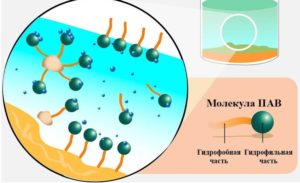 In addition to active ions, detergents contain enzymes - special enzymes that effectively remove all types of contaminants. The vast majority of laundry formulations designed for low temperature wash programs include enzymes. But these enzymes completely die in water heated to 60-90°C, so they are not applicable for high-temperature conditions.
In addition to active ions, detergents contain enzymes - special enzymes that effectively remove all types of contaminants. The vast majority of laundry formulations designed for low temperature wash programs include enzymes. But these enzymes completely die in water heated to 60-90°C, so they are not applicable for high-temperature conditions.
Phosphates are deservedly considered the most dubious component of household chemicals. They are needed to soften the liquid. However, phosphates lead to severe pollution of natural water bodies, so in many countries their use in laundry chemicals is strictly prohibited. The percentage of phosphates in cleaning products is regulated by regulatory authorities; their amount cannot be more than 8%. Most manufacturers of household chemicals announce that their content in their products does not exceed five percent.
No matter how hard it is to talk about it, it is unrealistic to completely abandon the use of phosphates in cleaning products; this will certainly affect the quality of washing clothes. You will have to either increase the volume of surfactants in the composition, and this will lead to the fact that it will take a very long time to rinse out particles from the fabric, or install powerful filters in the apartment to purify water, which is also impossible. Therefore, phosphate-free household chemicals will a priori be less effective in combating pollution.
Liquid solutions for light-colored items contain optical brighteners. The most common is titanium dioxide.Very small amounts of bleach particles remain on items after rinsing, reflect light rays and give the fabric a blue glow. This component is absolutely safe for humans, it does not have any harmful effects.
It is easy to add all kinds of natural extracts, extracts, essential oils, fabric softening components, mineral salts, additives to combat unpleasant odors and maintain the original appearance of products into liquid washing gels. This gives one more point to the gel box.
The most popular laundry detergents
Let us take the liberty of making a brief overview of the most effective and proven detergents used for washing in automatic machines. So, the top eight are:
- Gel Persil. It received a large number of positive customer reviews and gained immense popularity due to its ability to release oxygen and remove the most difficult and stubborn stains. On the shelves you can find not only the gel form, but also small granules, special capsules, grouped separately for colored clothes, baby items, white fabrics, and delicate items. The average cost for a 2.19 liter package is 584 rubles.
- Liquid Frosh is a German development containing only plant components. Phosphate-free product. It is considered as safe as possible for both people and nature. The price for a two-liter bottle is 700 rubles.
- Ariel gel from P&G easily defeats stubborn stains, and after washing, things acquire special softness and a delicate aroma. A 1.95 liter container can be purchased for $5.
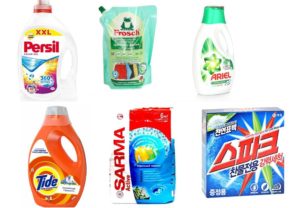
- The gel-like Tide product is suitable for cleaning items made from various fabrics, using any washing mode.According to research, a three-liter bottle of the substance will replace 9 kg of powder. The cost of a 1.82 liter bottle is 346 rubles.
- Sarma Active Lily of the Valley is one of the most effective and at the same time inexpensive dry powders. The price per pack is around $0.5, which is lower than the cost of advertised brands. Suitable for different types of fabric, copes well with stains, has an antibacterial effect, and whitens light-colored items. However, the powder contains a large amount of anionic substances, including phosphates, sulfates, and the addition of optical whitening particles. Therefore, it is better to refuse to use the powder when washing children’s clothes, underwear and bed linen.
- Korean SparkDrumLaundryDetergent is characterized by excellent washing quality even at low temperatures, and produces antibacterial treatment of laundry. The composition contains surfactants, enzymes, zeolites, natural tea and lemon extracts, soda, sea salt. For a large package of the product you will have to pay 700 rubles.
- The UdalixOxiUltra brand stain remover will dilute the rating. Along with its low cost, it has good washing properties. It will cope with stains from resin, grass, oil, and brilliant green without any problems. Packaged in plastic jars or bags, the price for 0.5 kg is only 200 rubles.
- The list of products ends with a balm designed for cleaning membrane products – DOMAL SportFelinFashion. Makes it possible to preserve all the properties of the coating without compromising the quality of things.
We hope the information provided will help you decide whether to choose gel or powder. A detailed review of the products will allow you to choose the ideal one.
Interesting:
Reader comments
- Share your opinion - leave a comment

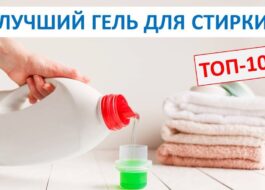
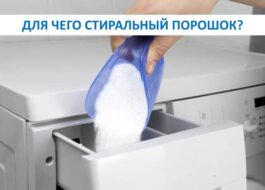
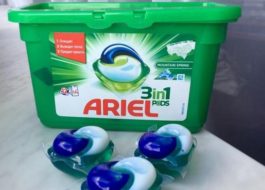
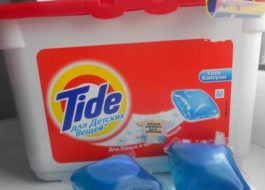
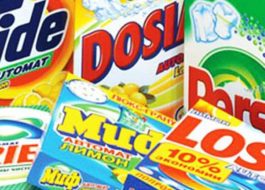
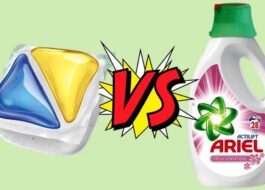














Add a comment